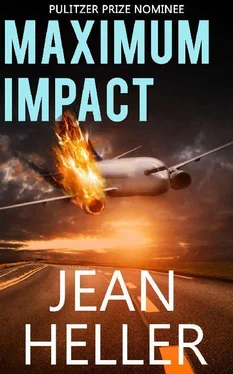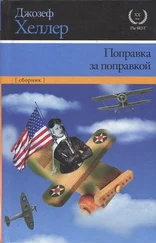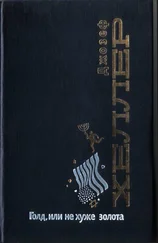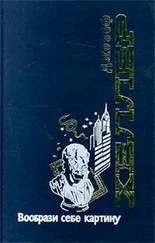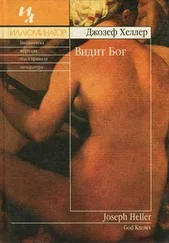“This is the first time I’ve felt good about the story in three days,” Pace said.
“I know. Hugh’s going to be in a lot better mood today, too.”
“Getting off the dime helps. At least something is happening.”
“So go forth and score one for the guys in the white hats.”
He held his arms out, a piece of luggage dangling from each hand. “How do I look? Good enough for Youngstown?”
“You’d look better without the yellow toilet paper on your Adam’s apple. It clashes with the red in your tie.”
“Oh, shit,” he said.
* * *
Pace read and reread the wire copy the messenger delivered to his door. He read it in the taxi, he read it in the waiting area before his plane began to board, and he read it twice during the flight to Youngstown. He began to fantasize about the press conference:
Someone inside Converse had embezzled funds used to pay for the cover-up of the cause of the ConPac accident. Harold Marshall had been on the take from Converse since the company began negotiations to move to Youngstown. That’s how he’d amassed the fortune to buy all the Converse stock he’d acquired. Marshall directed the cover-up and paid the bills; Chappy Davis was his agent. It was a wonderful fantasy, and it lasted until someplace over central Pennsylvania.
Then the inconsistencies began to gnaw at Pace: Why did anybody have to embezzle company funds to pay for the cover-up if Harold Marshall already had those funds in stock and cash?
Well, maybe the cover-up cost more than Marshall had.
Except Marshall hadn’t spent the whole four million. There was three million still in his checking account.
Maybe Converse officials embezzled funds to reimburse Marshall for his expenses in bankrolling the cover-up.
That angle had possibilities.
Maybe the embezzlement happened years earlier, when somebody at Converse originally misappropriated the funds Marshall used to buy the stock.
If so, why did it take so long for auditors to uncover the fraud?
Little of it added up, and the arithmetic was giving Pace a headache.
* * *
The Boeing 737 touched down at the Youngstown airport more or less on time, and Pace was on the road in twenty minutes. He found the federal building with only one wrong turn and pulled into a parking lot with more than an hour to spare. He locked his overnight bag in the trunk, taking only a pen and a notebook with him, and began walking through the city’s streets, not so much to get the flavor of the town as to try to break down the questions badgering his mind.
U.S. Attorney Allison Giavanova was a serious, no-nonsense prosecutor in both appearance and demeanor. It was a presence she cultivated to get past the fact that her family, two generations earlier, was prominent in running the gambling and prostitution vices for organized-crime syndicates in Cleveland, Youngstown, and Warren. She had an uncle in Lorain who was said to remain active in prostitution and drugs in the ethnic neighborhoods west of Cleveland. Giavanova, as an assistant U.S. attorney, once indicted her uncle, although he escaped conviction on a technicality. She never stopped trying to indict him again until she was promoted and moved to her current assignment. There was growing statewide interest in a Giavanova candidacy for governor, but she showed no inclination to run, preferring to devote her energies to razing what some of the more disreputable members of her family and their cronies had built over the years.
When she strode to the dais before an overflow crowd of reporters and photographers, the room grew silent in anticipation. Giavanova was dressed in a slim-fitting gray suit with a red-silk blouse and low-heeled red shoes that did little to raise her physical stature beyond her natural height of five-feet-four. Her dark-brown hair was pulled straight back from her face. She wore little makeup, rounding out the what-you-see-is-what-you-get image, and Pace liked her immediately.
“Ladies and gentlemen, thank you for coming. Late yesterday afternoon, a federal grand jury handed up indictments of a major local corporation, one of its chief officers, a high-level United States Senate aide, and two residents of Baltimore, Maryland, based on evidence of public corruption. A second officer of the corporation was named as an unindicted coconspirator. I regret I was unable to give you the opportunity to see the indictments before we began this press conference, but the task of making enough copies for all of you and getting them collated and stapled proved somewhat more arduous than my staff anticipated. The copies are coming now, and you will have them in ample time to ask questions.”
A quick reading showed that those indicted, in addition to the Converse Corporation itself, were George Thomas Greenwood, the company’s chief executive officer, and Chapman Davis. The two Baltimore men charged were identified as Sylvester Bonaro and Wade Stock. The unindicted coconspirator was Cullen Ferguson, vice-president of Converse for corporate relations. With growing apprehension, Pace scanned the papers again. He could find no mention of Harold Marshall’s name. Damn!
Giavanova continued. “It is the government’s contention that on April 17th of this year, George Greenwood, chief executive officer of the Converse Corporation, withdrew the sum of one million, one hundred thousand dollars from a discretionary company account he alone controlled and transferred the sum to Mr. Chapman Davis, the minority chief of staff of the Senate Committee on Transportation. In addition to the funds, Mr. Greenwood transmitted to Mr. Davis by facsimile machine a damaging personnel file on Elliott Parkhall. Mr. Parkhall had been named by the National Transportation Safety Board to head the team investigating the role played by Converse engines in the crash of Consolidated Pacific Flight 1117 at Dulles Airport in Chantilly, Virginia, earlier the same day. Mr. Greenwood intended and Mr. Davis understood that the funds were to be used for the purchase of an operation to intentionally falsify the cause of the crash in order to direct the blame for the accident away from the Converse Fan engines.
“On the same afternoon, April 17th, Mr. Davis, then in possession of the funds and the personnel material faxed to him by Mr. Greenwood, met with Mr. Parkhall on Theodore Roosevelt Island and transferred to Mr. Parkhall eight hundred fifty thousand dollars of the Converse funds. Mr. Davis also gave to Mr. Parkhall in a sealed container the remains of a red-tailed hawk, origins unknown, for dispersal throughout the severely damaged starboard engine of the Sexton aircraft. At the time, the engine was lying well away from the rest of the aircraft wreckage and was readily accessible to investigators from the National Transportation Safety Board, especially to those who, like Mr. Parkhall, were conducting the power-plants portion of the probe.
“It is further alleged that Mr. Parkhall, abetted by Sylvester Bonaro and Wade Stock, used a portable compressor to distribute the manufactured evidence into the demolished engine sometime during the evening of April 17th and further used a device, probably a portable acetylene torch, to burn some of the remains in order to simulate the post-crash fire. For their services, Mr. Parkhall paid Mr. Bonaro and Mr. Stock one hundred thousand dollars, retaining seven hundred fifty thousand dollars for himself, which he placed in a new account at the First Savings Bank of Alexandria, Virginia, under the alias of Ernest Peters. On another occasion, Mr. Davis paid Messrs. Bonaro and Stock directly for services rendered. The cash for that transaction came from the two hundred fifty thousand dollars that Mr. Davis had kept from the funds transferred by Mr. Greenwood. The funds were cached in Mr. Davis’s home in the false bottom of a bureau drawer.
Читать дальше
